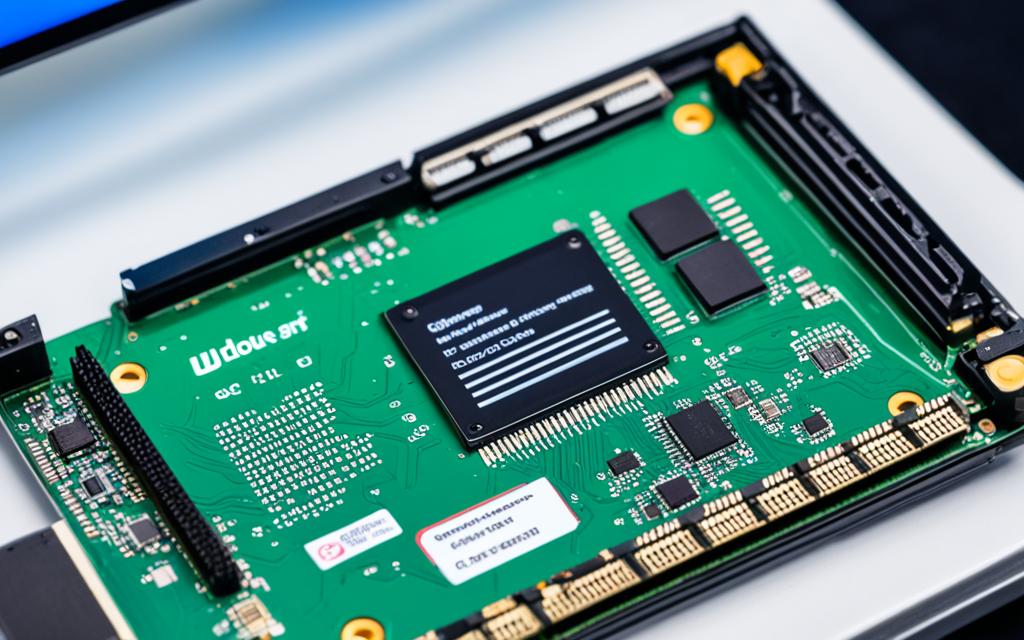Table of Contents
Welcome to your all-in-one guide on how to put Windows 10 on an SSD. Moving from old hard drives to SSDs isn’t just an upgrade. It’s a huge leap in speed and trustworthiness. When you set up Windows 10 on an SSD, you’ll see many perks. SSDs boot up and load apps faster, making your computer work quicker. They’re also more reliable since they don’t have moving parts that wear out.
This guide is here to help everyone, whether you’re starting out or you already know your way around computers. We provide simple, step-by-step advice to ensure your Windows 10 SSD setup goes smoothly. You can gain extra tips on the installation journey here. Discover how SSDs can make a big difference in how you use your computer.
Key Takeaways
- SSDs deliver substantial performance improvements for Windows 10 installations.
- Increased reliability and durability are key advantages of SSDs.
- Backing up data is crucial before initiating the installation process.
- A minimum 8 GB USB flash drive is required for the installation media.
- Cloning your existing OS to an SSD can simplify the transition.
- Post-installation steps are essential for optimising your SSD.
- Follow a guide to Windows 10 SSD installation for a seamless experience.
Why Choose SSD for Installing Windows 10?
Thinking about upgrading your operating system? The advantages of SSD stand out clearly. Switching to SSD can make your computer faster and more efficient. It’s vital to know why, such as better performance and longer lifespan, when choosing.
Performance Improvements
SSDs beat traditional HDDs because they use flash memory. This makes your computer start up quicker, launch apps faster, and run smoother. It boosts productivity by allowing you to do more at once without slowing down1. If you install Windows 10 on an SSD, you’ll enjoy faster access times, reduced delays, and less noise when it’s working2.
Durability and Reliability
SSD’s toughness is a big plus. They have no moving bits, so they’re less likely to get damaged from drops or bumps. This means they last longer, keeping your data secure1. SSDs also run cooler and quieter, making for a better computer use experience3. Remember, setting things up right from the start ensures you get all the reliability benefits of SSDs.
Preparing for the Installation
Getting your new SSD ready for Windows 10 is important. It can really make a difference in how well it all goes. Making sure you’re ready helps the installation go smoothly and quickly. Here, we’ll look at what you need to do for a good setup, including the tools you’ll need and how to keep your data safe.
Gathering Required Tools
Before you begin, collecting the right tools for the Windows 10 installation is crucial. You’ll need a few key items:
- SATA connection for the SSD
- USB flash drive (minimum 8GB)
- Installation media
- Cloning software, such as MiniTool Partition Wizard, if moving from another operating system
Checking that your new SSD fits well with your motherboard is key for a smooth setup. SSDs are faster in reading and writing data, which means your computer starts up quicker and runs more smoothly. Using a USB for the Windows install is a popular choice because it’s fast1.
Backing Up Data
Back up your data well before you start installing. It’s really important to avoid losing anything important. Think about moving important files to an external drive or the cloud. This step is extra important if you’re replacing a drive that has important personal information. Lots of people choose to move their current Windows 10 to the new SSD to keep their data safe1. With everything backed up, you can move to your new system without worry.
| Tool | Description |
|---|---|
| SATA Cable | Connects the SSD to the motherboard for data transfer. |
| USB Flash Drive | Used for creating the Windows 10 installer. |
| Installation Media | Provides the necessary files to install Windows 10. |
| Cloning Software | Helps move the OS from an old drive to the SSD. |
In conclusion, if you prepare your SSD well and back up your data, you’ll be set for a smooth switch to Windows 10.
How to Install Windows 10 on SSD
Installing Windows 10 on an SSD boosts speed and performance. There are two main methods for Windows 10 SSD installation. Each has its unique benefits for different user needs.
Option 1: Using a USB Installation Media
This approach uses a bootable USB drive with the Windows 10 files. Download the Microsoft Media Creation Tool to make the USB installation easy. You’ll need a USB flash drive with at least 8 GB. Boot from the USB to install Windows 10 on the SSD. This method allows a clean install, so you can keep old files or start new. It usually installs faster, offering a seamless experience for upgrading system performance.
Option 2: Cloning the Existing Operating System
Cloning the OS to an SSD is another effective method. Use software like AOMEI Partition Assistant or MiniTool Partition Wizard. This is great if your hard drive is failing or you need more space. It moves all data and apps safely, avoiding data loss. This choice suits many because it’s straightforward.
Always follow a detailed guide when installing. Here’s one that can help. With Windows 10’s popularity for its speed, more people are moving to SSDs for a faster experience. Make sure to back up important data before starting. This protects your files during the change415.
Steps for Creating a Bootable USB Drive
Creating a bootable USB for Windows 10 is essential for a smooth setup on an SSD. It’s important to follow a step-by-step approach for efficiency.
Using Microsoft Media Creation Tool
The media creation tool guide offers an easy way to prepare your USB drive. Start by downloading the tool from Microsoft’s website. After downloading, open the tool and agree to the license terms. This step is crucial for moving forward.
Then, choose “Create installation media for another PC.” Pick your preferred language, edition, and system type. Make sure these match your SSD’s installation requirements.
Plugin your USB drive. It should have at least 8GB of space. This is necessary for making a bootable drive. Select the USB as the destination for your installation files. The tool will do the rest.
After it’s done, your USB is ready to boot and install Windows 10 on the SSD. This way, you have all you need for a smooth installation. For more help on making an SSD bootable, see the full guide on SSD booting6.
| Step | Action |
|---|---|
| 1 | Download the media creation tool |
| 2 | Run the tool and accept the terms |
| 3 | Select installation media options |
| 4 | Insert USB drive and select it as destination |
| 5 | Complete the process |
Following these steps carefully will make setting up Windows 10 on your SSD better. It leads to a great computing experience with more speed and dependability7.
Common Issues and Troubleshooting
When you install Windows 10 on an SSD, you might face some problems. Knowing these issues and how to fix them is key. It helps in making the Windows 10 installation process smoother and ensures successful SSD setup.
Installation Errors
One common problem is getting a message that says, “Windows cannot be installed to this disk.” This can happen if the disk’s partition style doesn’t match what’s needed. You might need to switch from MBR to GPT, or the other way around. Also, check if the motherboard’s boot settings in the BIOS match, to fix these errors8.
Boot Issues After Installation
After installation, you might find your PC doesn’t start from the SSD. This usually means the SSD isn’t set as the main boot device in the BIOS. To solve this, you should change the BIOS settings to make the SSD the first boot option. If the Master Boot Record (MBR) is damaged, it might need fixing as well910.
Post-Installation Steps for SSD
Once you’ve got Windows 10 up and running on your SSD, it’s important to configure SSD after installation. First, activate your Windows to use its full features. Then, make sure to install all necessary drivers for your computer’s parts. These steps make sure your system runs smoothly and works well with your hardware. It’s also wise to look for any system updates regularly. This keeps your computer running well and improves how it works.
Changing your power settings can help your laptop battery last longer. Using a feature like TRIM can also keep your SSD working well. TRIM lets your operating system tell the SSD which bits of data it doesn’t need anymore. This makes it easier for the SSD to manage its storage space well.
Choosing an SSD over a traditional HDD has lots of benefits. For instance, SSDs make your computer start faster and apps run smoother. Installing Windows on an SSD usually takes about 25-30 minutes, depending on how much you know. If you’re setting up a new system or changing the OS drive3
Many decide to boost their old computers by swapping the old HDDs for SSDs, attracted by benefits like less noise and faster data access. This helps in making optimize Windows 10 on SSD better. There are options for a fresh install or copying over an existing OS. This lets users pick the best way for them, improving their SSD use2.
Conclusion
This article has highlighted how to install Windows 10 on an SSD. We looked at the benefits like faster speed, better durability, and quieter operation. The move to an SSD means your PC will work better and faster thanks to flash memory technology. It’s more efficient than old hard drives1112.
By following this guide, moving to an SSD is easy and keeps your data safe. You’ll see quicker startup times and faster loading of apps. With the right prep and knowledge of installation and fixing any issues, you’re setting yourself up for success. This change will make your PC respond faster and work more efficiently11.
Moving to an SSD for Windows 10 can really change your computer use for the better. It makes your PC last longer and run more powerfully. You should feel confident to upgrade your system for a better everyday computer experience12.
FAQ
What are the main benefits of installing Windows 10 on an SSD?
Installing Windows 10 on an SSD offers major benefits. You get a faster computer with quick boot times and speedy app launches. Also, SSDs are tougher and less likely to fail, making them more reliable over time.
How do I prepare for the installation of Windows 10 on an SSD?
Prepare by collecting things you need. This includes a SATA connection and a USB flash drive with at least 8GB. Make sure your SSD fits your computer. And don’t forget to back up your files to keep them safe.
What methods can I use to install Windows 10 on my SSD?
There are two ways to get Windows 10 on your SSD. You can create a bootable USB with Windows 10 on it. Or, you can clone your current system to the SSD using cloning software. Both ways make upgrading simple.
How can I create a bootable USB drive for Windows 10 installation?
To make a bootable USB, first download the media creation tool from Microsoft’s site. Follow the setup guide, agree to the terms, and choose “Create installation media for another PC.” Then, put your USB drive in and finish the setup. This USB will help you install Windows.
What common issues should I be aware of during the instalation?
You might face some problems during install, like errors about disk partitions or the computer not starting right. For partition errors, check the disk settings. And if it won’t start, check your computer’s BIOS to make the SSD the main boot device.
What steps should I take post-installation to ensure optimal performance?
After setting up Windows on your SSD, there are things to do for the best performance. Activate Windows and update your system. Install any drivers you need and change power settings to save battery. Turning on TRIM can also help keep your SSD fast.
Source Links
- https://www.diskpart.com/windows-10/install-windows-10-on-ssd-4348.html – How to Install Windows 10 on SSD Easily and Successfully
- https://www.ubackup.com/windows-10/install-windows-10-to-ssd.html – Directly Install Windows 10 on New SSD with/without CD | 2 Ways
- https://www.easeus.com/partition-master/install-windows-10-on-ssd.html – How to Install Windows on SSD via 2 Easy Ways 🏆
- https://www.partitionwizard.com/partitionmanager/install-windows-10.html – How to Install Windows 10 on a New Hard Drive (with Pictures) – MiniTool Partition Wizard
- https://www.dell.com/support/kbdoc/en-us/000132465/windows-10-install-with-nvme-ssd-and-sata-drives – Windows 10 install with NVMe SSD and SATA drives
- https://www.easeus.com/disk-copy/clone-resource/install-windows-10-on-new-hard-drive-from-usb.html – Install Windows 10 on New Hard Drive from USB on Laptop & PC🔥
- https://www.diskpart.com/articles/make-ssd-bootable-windows-10-7201.html – How to Make SSD Bootable on Windows 10 And Boot from It
- https://www.asus.com/support/faq/1043244/ – [Windows 11/10] Troubleshooting – Solid State Drive (SSD) problems | Official Support | ASUS Global
- https://www.digitaltrends.com/computing/easy-ways-fix-ssd-not-showing-windows/ – SSD not showing up in Windows? Here are some easy fixes | Digital Trends
- https://www.makeuseof.com/6-ways-to-fix-the-ssd-not-recognized-error-in-windows-10/ – 6 Ways to Fix the “SSD Not Recognized” Error in Windows 10
- https://www.passfab.com/partition-manager/install-windows-10-on-new-ssd.html – Step-by-step Guide on How to Install Windows on New SSD
- https://softkeys.uk/blogs/blog/how-to-install-windows-10-on-ssd – How to Install Windows 10 on Ssd?








